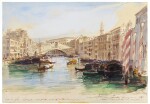Old Master Drawings
Old Master Drawings

Edward Lear
The Grand Canal looking towards the Rialto Bridge, Venice
Auction Closed
January 27, 05:29 PM GMT
Estimate
20,000 - 30,000 USD
Lot Details
Description
Edward Lear
London 1812 - 1888 San Remo
The Grand Canal looking towards the Rialto Bridge, Venice
Pen and brown ink and watercolor over pencil;
dated lower right: 13 November 1865 (2.pm), extensively inscribed with the artist's color notes
352 by 504 mm; 13 7/8 by 19 7/8 in
their sale, London, Sotheby's, 16 December 2002, lot 72,
where acquired by the present owner
The present watercolor was drawn during Lear’s second trip to Venice in 1865. He first visited the city in 1857 and was not particularly impressed. In a letter to his sister, Ann, he complained greatly of the ‘stinking canals’ and revealed that ‘Cooke’s and Canalette’s [sic] pictures please me far better than the actual appearance of the city.’1His return in 1865 was prompted by a commission from Lady Waldegrave to make an oil painting. During this trip he was far more impressed, particularly by the architecture and abundance of color. On 13th November, the day he drew the present watercolor, he rose early, ‘had a cup of cafe noir in the hotel – and then got a gondola for the day. First drew S(anta)-M(aria) de S(alute) by [the] Doge’s Palace – then from the Iron Bridge… but it was very cold.’2 The cold weather also brought with it a number of days of bright sunshine which reflected off the water in the canals and changed the character of the city, causing Lear to exclaim ‘anything so indescribably beautiful as the colour [sic] of the place I never saw’.3
This watercolor was once owned by Charles and Barbara Robertson who married in 1935. They were both heirs to confectionary fortunes. He was the great-grandson of James Robertson, the Scottish founder of the jam firm and she was descended from Dr Joseph Fry, who is credited with selling the world's first chocolate bar in 1847.
1. V. Noakes, Edward Lear, London, 1985, p. 152
2. Ibid, p. 116
3. Ibid, p. 116
